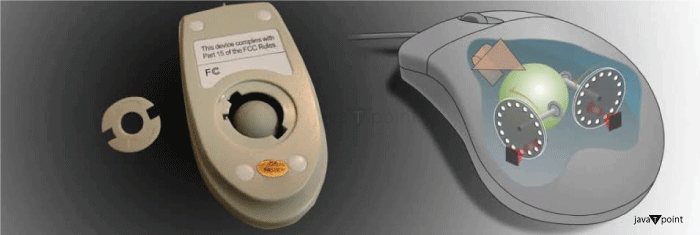What is an opto mechanical mouse?The optical-mechanical or optomechanical mouse is also known as the ball mouse. It has two internal wheels that are each moved by a ball. A circle of perforations or notches surrounds each wheel, allowing an LED light to shine through and be picked up by a sensor. When the wheel rotates, these lights serve as the x-axes and y-axes for the mouse pointer on your screen. This mouse is not as exact as an optical mouse, but it is more accurate than a mechanical mouse that solely uses wheels and rollers. 
This mouse is developed by the Douglas Engelbart of the Stanford Research Institute in 1963. The rotation of each gear wheel translated into motion along one axis in the plane in the initial machines, which were large and featured two gear wheels perpendicular to each other. A single internal ball that could rotate in any direction and whose motion was sensed by perpendicular wheels located inside the mouse's body had taken the role of the external wheels by the early 1970s. This mouse model resembled an upside-down trackball. The usual user input method (i.e., a keyboard) was included in the first PCs. In 1982, Microsoft released the first mouse made specifically for use with their word editing program. The inverted trackball style of mouse had become necessary by the end of the 1980s for those systems running on the GUI-based Windows operating system. Through the 1990s, it remained the most commonly used mouse with personal computers. An optoelectronic mouse has a steel ball with a rubber coating for weight and grip. The ball rotates as the mouse moves, driving two rollers, one for each direction of movement, x and y. In opposition to the other two, a third spring-loaded roller holds the ball in place. After that, these rollers rotate two discs that have radial slots carved into them. Two offset light-emitting diodes (LEDs) and light sensors are located within each photo-detector cell, which each disc rotates between. The offset between the two light sensors reveals the direction of movement when the disc rotates, and the sensors observe a light that appears to flash, indicating movement. Each button's switch is also located inside the mouse, along with a microcontroller that interprets the signals from the switches and sensors, converting them to X and Y velocities and then converts into data packets that are delivered to the PC through its firmware software. X, Y, and button presses are reported by serial mice using voltages of 12V and a Microsoft asynchronous protocol with three bytes per packet. A communications protocol and interface created by IBM are used by PS/2 mice, which operate on 5V. What distinguishes a mechanical mouse from an optical mouse?There are mainly two types of computer mice used to input commands into a computer system: a mechanical mouse and an optomechanical mouse. An optomechanical mouse tracks movement using a laser or LED while a ball is used in a conventional mouse to track movement. A sensor detects movement and turns it into a movement of the pointer on the computer screen once the laser or LED lights the surface beneath the mouse. A ball at the bottom of a mechanical mouse tracks movement. As the mouse is moved, the ball rotates, and the mechanical components in the mouse translate the rotation of the ball into movement of the cursor on the computer screen. The way the two types of mice track movement is their primary distinction. A mechanical mouse relies on a ball's movement, which can become filthy or jammed with debris and cause the pointer to move erratically. However, an optomechanical mouse employs a laser or LED to track movement, which is more accurate and reliable. The pointer's movement is also smoother and more precise with an optomechanical mouse because it doesn't need to touch the surface it is being used on physically.
Next TopicWhat is Google Map and how do you use it
|
 For Videos Join Our Youtube Channel: Join Now
For Videos Join Our Youtube Channel: Join Now
Feedback
- Send your Feedback to [email protected]
Help Others, Please Share










